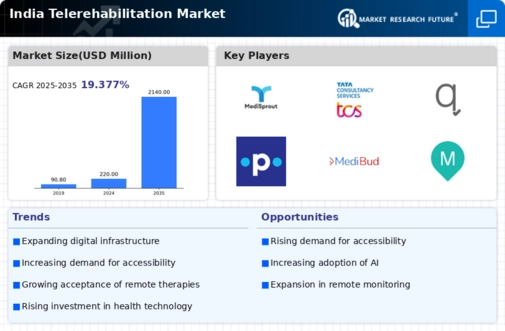Rising Demand for Accessible Healthcare
The telerehabilitation market in India is experiencing a notable surge in demand for accessible healthcare solutions. With a significant portion of the population residing in rural areas, access to traditional rehabilitation services remains a challenge. Telerehabilitation offers a viable alternative, enabling patients to receive care from the comfort of their homes. According to recent data, approximately 70% of India's population lives in rural regions, where healthcare facilities are limited. This growing demand for accessible services is likely to drive the telerehabilitation market, as it provides a solution to bridge the gap between patients and healthcare providers. Furthermore, the increasing awareness of rehabilitation services among the population is expected to contribute to the market's expansion, as more individuals seek out these innovative solutions.
Integration of Health Insurance Coverage
The integration of health insurance coverage for telerehabilitation services is emerging as a crucial driver for the telerehabilitation market in India. As insurance companies begin to recognize the value of telehealth services, more policies are being developed to include coverage for telerehabilitation. This shift is likely to alleviate financial barriers for patients, making these services more accessible. Recent reports indicate that approximately 30% of health insurance plans in India now offer some form of telehealth coverage, which is expected to increase in the coming years. As patients become more aware of their insurance options, the demand for telerehabilitation services is likely to rise, further propelling the market's growth. This integration not only benefits patients but also encourages healthcare providers to adopt telerehabilitation as a standard practice.
Technological Advancements in Communication
Technological advancements in communication are playing a pivotal role in shaping the telerehabilitation market in India. The proliferation of smartphones and high-speed internet connectivity has made it easier for patients to access rehabilitation services remotely. As of November 2025, mobile internet penetration in India stands at approximately 50%, facilitating the use of telehealth applications. These advancements not only enhance the quality of care but also improve patient engagement and adherence to rehabilitation programs. The integration of artificial intelligence and machine learning into telerehabilitation platforms further personalizes the patient experience, making it more effective. Consequently, these technological innovations are likely to propel the growth of the telerehabilitation market, as they provide efficient and user-friendly solutions for both patients and healthcare providers.
Government Initiatives Supporting Telehealth
Government initiatives aimed at promoting telehealth services are significantly influencing the telerehabilitation market in India. The Indian government has recognized the potential of telehealth in improving healthcare access and has implemented various policies to support its growth. For instance, the National Digital Health Mission aims to create a digital health ecosystem that facilitates the delivery of healthcare services through technology. Such initiatives are expected to enhance the infrastructure necessary for telerehabilitation services, thereby increasing their adoption among healthcare providers. Additionally, funding and incentives for telehealth startups are likely to foster innovation within the telerehabilitation market, encouraging the development of new solutions that cater to diverse patient needs.
Growing Awareness of Rehabilitation Benefits
There is a growing awareness of the benefits of rehabilitation services among the Indian population, which is positively impacting the telerehabilitation market. As more individuals recognize the importance of rehabilitation in recovery and overall health, the demand for these services is expected to rise. Educational campaigns and outreach programs by healthcare organizations have contributed to this increased awareness, highlighting the effectiveness of telerehabilitation in managing chronic conditions and post-surgical recovery. This shift in perception is likely to drive more patients to seek telerehabilitation services, thereby expanding the market. Furthermore, as healthcare providers increasingly incorporate telerehabilitation into their offerings, the overall acceptance and utilization of these services are anticipated to grow.

















Leave a Comment